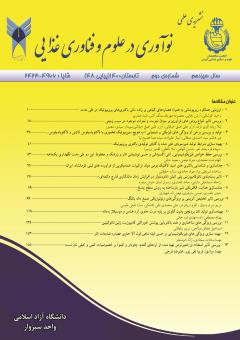مدلسازی هدایت الکتریکی شیر بازساخته به روش سطح پاسخ
محورهای موضوعی :
اصول مهندسی صنایع غذایی-مدل سازی
حیدر ناصری
1
,
عیسی حزباوی
2
*
,
فیض اله شهبازی
3
1 - دانشآموخته کارشناسی ارشد، گروه مهندسی بیو سیستم، دانشکده کشاورزی، دانشگاه لرستان، خرمآباد، ایران
2 - استادیار، گروه مهندسی بیوسیستم، دانشکده کشاورزی، دانشگاه لرستان، خرم آباد، ایران
3 - دانشیار، گروه مهندسی بیو سیستم، دانشکده کشاورزی، دانشگاه لرستان، خرمآباد، ایران
تاریخ دریافت : 1397/11/29
تاریخ پذیرش : 1398/02/14
تاریخ انتشار : 1400/04/01
کلید واژه:
هدایت الکتریکی,
روش سطح پاسخ,
شیر بازساخته,
چکیده مقاله :
شیر تنها ماده شناخته شده در طبیعت است که می تواند نیاز بدن را به طور کامل و متعادل تامین کند. شیر بازساخته یک محصول جایگزین شیر است. اجزای شیر بازساخته به راحتی قابل تنظیم تر از شیر است. با استفاده از هدایت الکتریکی میتوان اطلاعات ارزشمندی در مورد کیفیت مواد مختلف از جمله مواد غذائی بدست آورد و بوسیله این روش، به عنوان یک ابزار ساده و کاربردی، کیفیت بسیاری از مواد غذایی را کنترل نمود. در این تحقیق روش سطح پاسخ برای مدلسازی و بهینه سازی هدایت الکتریکی شیر بازساخته مورد استفاده قرار گرفت. اثر پروتئین (1، 2، 3، 4 و 5 درصد) لاکتوز (4، 6، 8، 10 و 12 درصد)، چربی (3 و 6 درصد) و دما (50، 55، 60، 65 و 70 درجه سلسیوس) به عنوان متغیرهای مستقل بر هدایت الکتریکی شیر باز ساخته به عنوان متغیرهای وابسطه (پاسخ) مورد ارزیابی قرار گرفت. متغیرهای فرایند به صورت مدلهای رگرسیونی درجه دوم برای این پاسخ معنی دار بودند (01/0p <). ضریب تبیین (R2) مدلسازی هدایت الکتریکی شیر بازساخته به روش سطح پاسخ برابر با 92/0 به دست آمد. شرایط بهینه برای قرار گرفتن هدایت الکتریکی شیر بازساخته در محدوده معمول آن (4 تا mS/cm 5/5) شامل پروتئین 4/3%، لاکتوز 7/7%، چربی 3% و دمای ºC9/63 بدست آمد.
منابع و مأخذ:
سالاری، ر.، مرتضوی، ع. 1387. تعیین زمان بهینه رسیدن پنیر سفید ایرانی با استفاده از روش سطح پاسخ. فصلنامه علوم و صنایع غذایی، جلد5، شماره2، 26- 17.
Chauhan, A. and Srivastava, A. 2009. Optimizing drying conditions for vacuumassisted microwave drying of green peas (Pisum sativum L.). Drying Technology, 27(6): 761-769.
Crow, D.R. 1994. Principles and application of electro chemistry. 4th ed. Glasgow: Blackie Academic and Professional. Glasgow, UK.
Dejmek, P. 1989. Precision conductometry in milk renneting. J Dairy Res, 56 (1): 69-78.
Gelais, D., Champagne, C.P., Erepmoc, F. and Audet, P. 1995. The use of electrical conductivity to follow acidifcation of dairy blends. Int Dairy J, 5: 427 438.
Kahyaoglu, T. 2008. Optimization of the pistachio nut roasting process using response surface methodology and gene expression programming
. Food Science and Technology, 41: 26-33.
Lampert, I.M. 1978. Modern Dairy 3th ed. CRC.USA, p. 92- 132.
Loveland, J.W. 1986. Conductance and oscillometry. 2nd ed., USA: Allyn and Bacon, p. 122-43.
Luck, H. and Screed, D. 2002 The use of hydrojenpeoxide in milk and Dairy products. Ger Res Inst Food Chem, 3: 423-452 .
Maatje, K., Huijsmans, P.J.M., Rossing, W. and Hogewerf, P.H. 2002. The efficacy of in-line measurement of quarter milk electrical conductivity, milk yield and milk temperature for the detection of clinical and subclinical mastitis. Livest Prod Sci, 30: 239-249.
Mabrook, M. and Petty, M. 2003. Effect of composition on the electrical conductivity of milk. J Food Eng, 69 (3): 321-325.
Mabrook, M. F. and Petty, M.C. 2002. Application of electrical admittance measurements to the quality control of milk. Sensors and Actuators B, 84: 136–141.
Nielen, M., Deluyker, H., Schukken, Y.H. and Brand, A. 1992. Electrical conductivity of milk: measurement, modifers, and meta analysis of mastitis detection performance. J Dairy Sci, 75 (2): 606 614.
Norberg, E., Hogeveen, H., Korsgaard, I.R., Friggens, N.C. and Lbvendahl, P. 2004. Electrical conductivity of milk: ability to predict mastitis status. Dairy Sci, 87: 1099–1107.
Noshad, M., Mohebbi, M., Shahidi, F. and Mortazavi, S.A. 2012. Multi-objective optimization of osmotic–ultrasonic pretreatments and hot-air drying of quince using response surface Food and Bioprocess Technology, 5(6): 2098-2110.
Ozdemir, M., Ozen, B.F., Dock, L. and Floros, J.D. 2008. Optimization of osmotic dehydration of diced green peppers by response surface methodology. LWT-Food Science and Technology, 41(10): 2044-2050.
Paquet, J., Lacroix, C., Audet, P. and Thibault, J. 2000. Electrical conductivity as a tool for analysing fermentation processes for production of cheese starters. International Dairy Journa,l 10: 391-399.
Park, K.J., Bin, A. and Brod, P. 2003. Drying of pear d’Anjou with and without osmotic dehydration. Journal of Food Engineering, 56(1): 97-103.
Petzer, I.M., Donkin, E.F., Du Preez, E., Karzis, J., Van der Schans, T.J., Watermeyer, J.C. and Reenen, R. 2008. Value of tests for evaluating udder health in dairy goats: somatic cell counts, California Milk Cell Test and electrical conductivity. Onderstepoort. J Vet Res, 75: 279– 287.
Prentice, J.H. 1962. The conductivity of milk the efect of the volume and degree of dispersion of the fat. J Dairy Res, 2: 131 139.
Sharma, G.S. and Roy, D.N.K. 1976. Influence of temperature on the electrical conductivity of buffalo milk. J Dairy Res, 43: 321-323.
Shin, J., Yang, D., Gan, L., Hong, S., Lee, E., Park, S. and Lee, K. 2012. Preparation of recombined milk using modified butterfats containing α-linolenic acid. Journal of Food Science, 78(1): 17-24.
Therdthai, N. and Zhou, W. 2001. Artificial neural network modelling of the electrical conductivity property of recombined milk. Journal of Food Engineering, 50 (2): 107–111.
Uysal, N., Sumnu, G. and Sahin, S. 2009. Optimization of microwave–infrared roasting of hazelnut. Journal of Food Engineering, 90: 255-61.
Zhuang, W., Zhou, W., Nguyen, M.H. and Hourigan, J.A. 1997. Determination of protein content of whey powder using electrical conductivity measurement. Int Dairy J, 7(10): 647 653.

